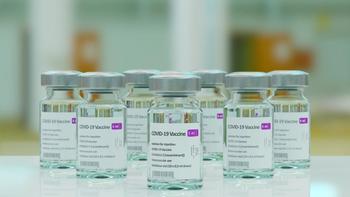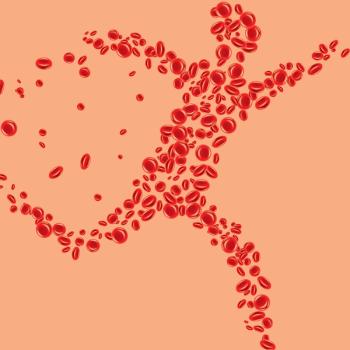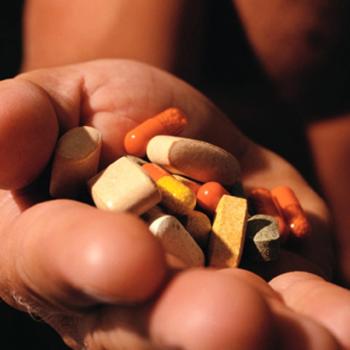
The combination of Calquence and Rituxan may also be useful during the COVID-19 pandemic as it decreases infusion times and patient interactions, according to an expert.

The combination of Calquence and Rituxan may also be useful during the COVID-19 pandemic as it decreases infusion times and patient interactions, according to an expert.

Most patients with acute myeloid leukemia and myelodysplastic syndrome achieved strong antibody responses to COVID-19 vaccination, according to recent study results.

Overall survival in metastatic gas­tric or gastroesophageal junction cancer improved significantly in patients who received the oral combination chemo­therapy Lonsurf regardless of whether they’d had a gastrectomy.

Patients with previously untreated liver cancer, or hepa­tocellular carcinoma (HCC), lived twice as long if they responded to a tyrosine kinase inhibitor, a type of targeted therapy.

Combining two immunotherapies known as checkpoint inhibitors along with best supportive care prolonged life by two and a half months in patients with advanced colorectal cancer that resisted previous treatments.

The experimental oral anticancer regimen known as SM-88, which com­bines four drugs from different classes, shows promising efficacy and safety with no meaningful toxicity in patients with metastatic pancreatic cancer whose disease worsened despite previous treatment.

Nearly half of patients with a particular type of cholangiocarcinoma responded to a combination of two targeted drugs — Tafinlar (dabrafenib) and Mekinist (trametinib), which together inhibit the growth-signaling proteins BRAF and MEK in patients with different types of rare cancers that carry the BRAF V600E gene mutation.

Novel immunotherapies either release the immune system’s parking brake or hit its gas pedal.

Treatment with the PD-1 inhibitor Keytruda (pembrolizuumab) elicited promising progression-free survival (PFS) and overall survival (OS) results in patients with advanced hepatocellular carcinoma (HCC) who received previous treatment with Nexavar (sorafenib), according to phase 2 findings.

Patients with relapsed/refractory multiple myeloma should be given individualized treatment approaches guided by the biology of their disease, frailty of the patient and other comorbidities, said Natalie S. Callander, M.D., who presented on the topic at the NCCN 12th Annual Congress: Hematologic Malignancies in San Francisco, California.

For the past four decades, there have been few advances in the treatment field of acute myeloid leukemia (AML). However, in the year 2017, there have been four new drugs approved by the FDA to treat the disease, with even more promising agents in the pipeline.

The ratio of neutrophils to lymphocytes – two types of white blood cells – can give oncologists valuable information regarding a patient’s prognosis.

In a recent phase 2 study, nearly half of patients who had resectable stage 3B/C BRAF V600-mutant melanoma achieved pathologic complete response (pCR) – meaning that no active cancer cells are present – with neoadjuvant combination therapy consisting of Tafinlar (dabrafenib) and Mekinist (trametinib).

Immunotherapy and PARP inhibitor combinations may be the future of ovarian cancer treatment, says Samir N. Khleif, M.D.

The future of treating ovarian cancer may lie in combinations of immunotherapy plus PARP inhibitors, says Samir N. Khleif, M.D.

Tagrisso (osimertinib) had positive outcomes for patients with T790M-positive non–small cell lung cancer (NSCLC) for central nervous system (CNS) metastases.

Treatment changes for the rare illness include less invasive surgery.

Patient education and coordination from the care team are two vital aspects in delivering successful CAR T therapy.

A new combination was shown to mitigate graft-versus-host disease (GVHD) for patients undergoing a hematopoietic stem cell transplant (HSCT).

Axicabtagene ciloleucel had high response rates in patients with non-Hodgkin lymphoma in a phase 2 study.

There were promising results when Abraxane was added to standard therapy to treat pancreatic cancer.

Surgical palliation improved quality of live and solid food intake in patients with certain types of gastric cancer, according to a recent study.

A three-drug combination showed both tolerability and favorable overall response rates (ORR) for patients with smoldering multiple myeloma in a phase 2 trial.

Ropeginterferon alfa-2b is noninferior to hydroxyurea (HU) when it comes to complete hematologic response to treat PV.

While the use of Kyprolis (carfilzomib), Pomalyst (pomalidomide) and KPd (dexamethasone) to treat some myeloma patients was "promising," researchers said that they will give the combination a closer look.

Data from the KEYNOTE-087 study showed overall response rates of about 70 to 80 percent in three separate groups of relapsed/refractory Hodgkin lymphoma patients.

Alecensa may be the new first-line therapy for some patients with lung cancer, after a recent study yielded promising results for the drug.

In the longest follow-up of an anti-PD-1 immunotherapy in RCC, about one-third of the patients treated with single-agent Opdivo are still alive four and five years later.

The combination of Yervoy and Opdivo showed a 42 percent improvement in overall survival compared with Yervoy monotherapy for patients with advanced melanoma in a two-year assessment of the phase 2 CheckMate-069 trial.

Treatment with the experimental agent elotuzumab in combination with Revlimid and dexamethasone demonstrated encouraging efficacy in patients with relapsed/refractory multiple myeloma in a phase 1b/2 study.

Published: December 7th 2016 | Updated:

Published: December 13th 2016 | Updated:

Published: January 24th 2017 | Updated:

Published: February 10th 2017 | Updated:

Published: February 27th 2017 | Updated:

Published: February 27th 2017 | Updated: